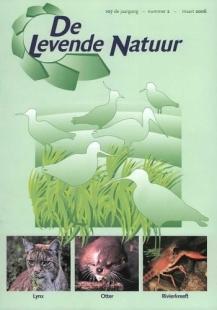De Levende Natuur nummer 2 van 2006 (English summary)
Afbeelding

Will the Eurasian lynx settle in The Netherlands?
Groot Bruinderink, G.W.T.A., H. Kuipers, D.R. Lammertsma, K. DeSmet, M. Petrak & H.H. Eylert
The Eurasian lynx (Lynx lynx) used to occur throughout Europe, but its current distribution is restricted to the scattered large continuous forest regions. Core areas are the Carpathians, the Alps, and the Balkan. Some areas like the Harz, Pfalz, the Jura Mountains and Vosges, hold recently reintroduced or otherwise settled populations. Potential new habitat in western Germany and The Netherlands has a patchy distribution and is poorly connected with currently occupied core areas. An important obstacle is the dense infrastructural network of main roads, secondary roads, canals, railroads etc. Chances are being discussed whether the species would benefit from the realisation of a western European ecological network for large mammals.
Reintroduction of the Otter in The Netherlands: a success story?
Lammertsma, D.R., F.J.J. Niewold, H.A.H. Jansman, A.T. Kuiters, H.P. Koelewijn, M.I. Perez Haro, M. van Adrichem, M.C. Boerwinkel & J. Bovenschen
After the extinction of the Otter (Lutra lutra) in The Netherlands in 1988, measures were taken to restore otter habitat in lowland peat marshes in the north of the country. A spontaneous recolonisation was not expected, reintroduction started in 2002 with the release of 15 otters in the lowland peat marsh area of the Weerribben, followed by another 8 in 2004-2005 in the adjacent Wieden area. The otter population was monitored using radio-telemetry and genetic techniques based on DNA-fingerprinting of spraints. Until now of the 23 released otters, 14 settled in their release area, 2 otters died shortly after their release and 7 did not settle. At least 9 otters were born from 5 different females, indicating that habitat quality seems sufficient. At present in total 11 animals were found dead (8 adults and 3 newborns), of which 9 were killed by traffic collision. The population remains vulnerable for extinction, and the additional release of new otters to supplement the population is now of utmost importance together with further measures to improve habitat quality (i.e. corridors, fencing).
Dispersal of salt-marsh species in the Waddensea
Wolters, M., J.J. Hogendorf, L.M. Willemse & J.P. Bakker
Salt-marsh species are able to float for some time in seawater. Tidal water may therefore play an important role in the dispersal and exchange of salt-marsh species between different areas. Knowledge about this process will be important for the planning and management of de-embankment schemes, which are aimed at restoring salt-marsh vegetation on formerly reclaimed land. An important question is whether dispersal by tidal water mainly occurs over short distances or whether long-distance transport is also possible. In the present study, floating diaspores have been trapped at different locations and in different seasons in the Dutch Waddensea. The results show that a total of 15 salt-marsh species have been trapped throughout the study period (fig. 2). The highest number of species was trapped in November (fig. 3), and the highest number of individuals in November and January, shortly after seed set (fig. 4). More species and individuals were trapped at the location that was relatively close to a well-developed salt marsh compared to the location that was far from a salt marsh. For the restoration of salt marshes after de-embankment, better results can be expected when a well-developed salt marsh is nearby. De-embankment should take place before October in order to take advantage of the dispersal peak for salt-marsh species.
Cattle grazing in the Amsterdam Water Supply dunes, disappointing or successful?
Til, M. van
In 1985 extensive cattle summer grazing was introduced at the Eiland van Rolvers, a coastal dune area in the western part of The Netherlands, part of the Amsterdam Water Supply dunes. Cattle grazing initially led to a varied vegetation with blow outs, dune grasslands and open dune scrub in the dry dunes, but could not prevent woodland development in dune slacks. Besides, in the 1990s the coverage of shrub and tall grass species started to increase, which seemed to be enhanced by the strong decline of rabbits. Cattle grazing did not have clear effects on ground beetles and butterflies, but had a negative effect on bird species that depend on Phragmites australis for breeding. However, it had positive effects on plant species, macrofungi, dung chafers, grasshoppers and dragonflies. This study made clear that grazing using large herbivores was successful, but that rabbits play an indispensable role in the maintenance of the coastal dune landscape with a varied vegetation and fauna.
Is exotic freshwater crayfish becoming a problem?
Soes, D.M. & R. van Eekelen
An overview of the freshwater crayfish occurring in The Netherlands, reveals a list of eight species. Only one is actually indigenous, the others mainly originate from North America. Four of these species have been discovered only in the last two years. The increase in species of crayfish is mainly due to release of specimens from the aquarium trade. Based on first impressions within The Netherlands and the literature, a serious impact on Dutch waters is likely to occur. We suggest that surveys of these possible effects and legislation to ban these harmful exotic species are necessary steps.
Earlier flowering in spring is not only a result of climate change
Londo, G.
Long-term phenological research confirms that climate change leads to an earlier flowering in spring. However, planted Prunus spinosa and Crataegus monogyna and sown Leucanthemum vulgare in verges are often flowering earlier than local wild populations of the same species. Probably this is due to import of exotic material, especially from southern Europe.

